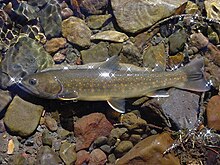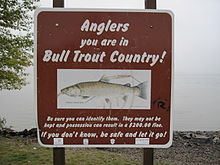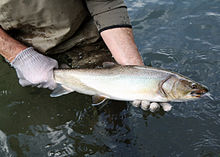Bull trout
| Bull trout | |
|---|---|

| |
| Scientific classification | |
| Domain: | Eukaryota |
| Kingdom: | Animalia |
| Phylum: | Chordata |
| Class: | Actinopterygii |
| Order: | Salmoniformes |
| Family: | Salmonidae |
| Genus: | Salvelinus |
| Species: | S. confluentus
|
| Binomial name | |
| Salvelinus confluentus | |
The bull trout (Salvelinus confluentus) is a
Description
Like other species of char, the fins of a bull trout have white leading edges. Its head and mouth are unusually large for salmonids, giving it its name. Bull trout have been recorded measuring up to 103 cm (41 in) in length and weighing 14.5 kg (32 lb).[4] Bull trout may be either migratory, moving throughout large river systems, lakes, and the ocean, or they may be resident, remaining in the same stream their entire lives.[6] Migratory bull trout are typically much larger than resident bull trout, which rarely exceed 2 kg (4.4 lb).[5] Bull trout can be differentiated from brook trout (S. fontinalis) by the absence of distinct spots on the dorsal fin, as well as yellow, orange, or salmon-colored spots on the back as opposed to red spots with blue halos on the brook trout. Bull trout lack the deeply forked tail fin of lake trout (S. namaycush, another char).[6]
Distribution and habitat

S. confluentus is found in the cold, clear waters of the high mountains and coastal rivers of northwestern
Bull trout have exacting habitat demands, requiring water temperatures generally below 55 °F (13 °C), clean
Dispersal
Bull trout are known for their extensive movements within river systems. They exhibit short-distance and long-distance movements, which are crucial in maintaining healthy populations and genetic diversity.
One of the primary reasons for bull trout dispersal is the need to find appropriate spawning areas. Bull trout rely on clean, cold water and gravels of specific sizes for successful reproduction.
Long-distance dispersal is also an essential aspect of bull trout ecology.[16] These movements often occur during the non-spawning season when the fish search for suitable feeding grounds or escape unfavorable conditions such as high water temperatures or low oxygen levels.[16] In some cases, bull trout have been observed moving between different river basins, crossing over mountain ranges, and even traversing large lakes.[17] These long-distance dispersal events contribute to gene flow between isolated populations, maintaining genetic diversity and increasing the species’ resilience.[18]
Understanding bull trout dispersal patterns is crucial for effective
Bull trout dispersal is a complex and vital aspect of their life history. Their movements are critical to maintaining population connectivity,
Feeding
Young bull trout feed on
Conservation

The bull trout is listed as a threatened species under the U.S. Endangered Species Act throughout its range in the contiguous United States.[6] In 1998, the Klamath River distinct population segment (DPS) and Columbia River DPS were federally listed as threatened.[21] This finding followed a legal challenge[22] to the U.S. Fish & Wildlife Service's (USFWS) decision in 1994[23] to assign a lower priority to the species' listing. The Jarbidge River DPS was listed as endangered under an emergency rule in 1998,[24] and was subsequently downgraded to threatened in 1999.[24] Finally, in determining that the Coastal-Puget Sound and St. Mary-Belly River DPS were threatened, the USFWS issued a threatened listing for all bull trout in the lower 48 states in 1999.[25]
In the United States, bull trout are used as a management indicator species for several national forests, including
They are a prized game fish in northern Canada. It was once maligned out of fear they threatened populations of other native species more prized by anglers. Some jurisdictions publicize the requirement to release with the slogan "No black, put it back".[28]
Within Canada, bull trout have been designated as a "species of Special Concern" by both the
Historical names




"Dolly Varden" in California
Historically, confusion has existed between S. confluentus and
The first recorded use of the name "Dolly Varden" for a fish species was applied to members of S. confluentus caught in the
My grandmother's family operated a summer resort at
Dolly Varden; also, the vogue in fashion for women at that time (middle 1870s) was called 'Dolly Varden', a dress of sheer figured muslin worn over a bright-colored petticoat. My grandmother had just gotten a new dress in that style and the red-spotted trout reminded her of her printed dress. She suggested to the men looking down at the trout, 'Why not call them "Dolly Varden"?' They thought it a very appropriate name and the guests that summer returned to their homes (many in the San Francisco Bay area) calling the trout by this new name. David Starr Jordan, while at Stanford University, included an account of this naming of the Dolly Varden trout in one of his books.
In 1874, Livingston Stone, a naturalist working for the U.S. government, wrote of this fish:[30]
Also called at (Upper) Soda Springs the 'Varden' trout. … The handsomest trout, and, on the whole, having the most perfect form of all the trout we saw on the McCloud. Also, the only fish that had colored spots. This one was profusely spotted over most of the body with redish [sic?] golden spots. ... The local name at (Upper) Soda Springs is the Dolly Varden.
It is currently unknown whether the name "Dolly Varden" was later applied to S. m. malma because of its similar appearance to S. confluentus; the two may have even been believed to be the same species. The name "Dolly Varden" may have also been given to S. m. malma independent of the McCloud River fish.[citation needed]
Ironically, the original "Dolly Varden" trout (i.e., S. confluentus) apparently likely became extirpated in the McCloud River in the 1970s, although reports continue of its being caught. Other fish species, typically introduced trout, outcompete S. confluentus, and can interbreed with them, resulting in sterile hybrids. An attempt to reintroduce S. confluentus to the McCloud was unsuccessful, and no additional attempts are expected.[31]
Other uses of "Dolly Varden"
The "Dolly Varden" name is also applied to the other subspecies of S. malma, the
The name has also been applied to S. alpinus, today more commonly known as Arctic char.[citation needed]
"Bull trout" in Europe
The name "bull trout" was also given in the past to some of the large sea trout that run the
References
- ^ . Retrieved 19 November 2021.
- ^ a b NatureServe (7 April 2023). "Salvelinus confluentus". NatureServe Network Biodiversity Location Data accessed through NatureServe Explorer. Arlington, Virginia: NatureServe. Retrieved 14 April 2023.
- ^ "Salvelinus confluentus". Integrated Taxonomic Information System. Retrieved 24 January 2006.
- ^ a b Froese, Rainer; Pauly, Daniel (eds.) (2009). "Salvelinus confluentus" in FishBase. May 2009 version.
- ^ a b c "U.S. Fish and Wildlife Service Bull Trout Facts" (PDF). Archived from the original (PDF) on 10 July 2012. Retrieved 8 February 2009.
- ^ a b c d e "Bull Trout (Salvelinus confluentus)". Environmental Conservation Online System. US Fish and Wildlife Service. Retrieved 14 April 2023.
- ^ a b "Bull Trout (Salvelinus confluentus), Saskatchewan - Nelson Rivers populations". Species at Risk Public Registry. Government of Canada. 2 February 2021. Retrieved 15 April 2023.
- ^ "Map C - Core Area By Distribution" (PDF). US Fish and Wildlife Service. 2005.
- ^ a b c Washington's Native Chars Archived 24 April 2009 at the Wayback Machine, Washington Department of Fish and Wildlife
- ^ a b "Ecology of the Bull Trout". Archived from the original on 18 August 2000. Retrieved 19 April 2009., King County, Washington
- ^ ISSN 0002-8487.
- ^ S2CID 24018113.
- ^ .
- ^ S2CID 19880632.
- .
- ^ ISSN 0363-2415.
- S2CID 14334731.
- S2CID 55800379.
- .
- ISSN 0888-8892.
- ^ 63 FR 31647
- ^ "Friends of the Wild Swan, Inc. v. United States Fish & Wildlife Service, 945 F. Supp. 1388". Caselaw Access Project. Harvard Law School Library. 13 November 1996. Retrieved 15 April 2023.
- ^ 59 FR 30254
- ^ a b 63 FR 42757
- ^ 64 FR 58910
- ^ "Preservation of Threatened Bull Trout in Glacier National Park" (PDF). USGS. Retrieved 24 September 2013.
- ^ Mateusz Perkowski (21 April 2018). "Judge Throws Out Lawsuit Claiming Grazing Hurts Oregon Bull Trout". OPB via AP Capital Press. Archived from the original on 21 April 2018.
- ^ "The bull trout has no black on its dorsal fin". Bull Trout Identification & Education Program. Montana Fish Wildlife and Parks Dept. Archived from the original on 2 October 2011. Retrieved 10 February 2012.
- ^ a b COSEWIC (2012). "COSEWIC Assessment and Status Report on the Bull Trout Salvelinus confluentus in Canada" (PDF). Ottawa: Committee on the Status of Endangered Wildlife in Canada. Retrieved 15 April 2023.
- ^ VI. Report of Operations During 1872 at the United States Salmon-Hatching Establishment on the M’Cloud River, and on the California Salmonidae generally; with a list of Specimens Collected. By Livingstone Stone. In: United States Commission of Fish and Fisheries. Part II. Report of the Commissioner for 1872 and 1873. A- Inquiry into the Decrease of the Food Fishes. B- The Propagation of Food-Fishes in the Waters of the United States. With Supplementary Papers. Washington: Government Printing Office, 1874 at pp. 203 - 207.
- ^ "Detailed history of Dolly Varden/Bull trout on McCloud River". Archived from the original on 18 February 2006. Retrieved 20 March 2006.
- ^ Use of Dolly Varden name in Japan


